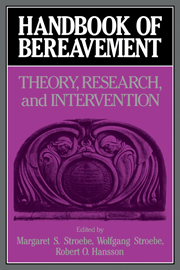Book contents
- Frontmatter
- Contents
- Contributors
- Preface
- Part I Introduction
- Part II The phenomenology and measurement of grief
- Part III Current theories of grief, mourning, and bereavement
- Part IV Physiological changes following bereavement
- Part V The psychological, social, and health impacts of conjugal bereavement
- Part VI Grief reactions to different types of loss
- 18 Loss and recovery
- 19 The death of a child is forever: The life course impact of child loss
- 20 Children's reactions to the death of a parent
- 21 Bereavement following death from AIDS: Unique problems, reactions, and special needs
- 22 Sleep and dreams in well-adjusted and less adjusted Holocaust survivors
- Part VII Coping, counseling, and therapy
- Part VIII Conclusions
- References
- Author index
- Subject Index
21 - Bereavement following death from AIDS: Unique problems, reactions, and special needs
Published online by Cambridge University Press: 04 May 2010
- Frontmatter
- Contents
- Contributors
- Preface
- Part I Introduction
- Part II The phenomenology and measurement of grief
- Part III Current theories of grief, mourning, and bereavement
- Part IV Physiological changes following bereavement
- Part V The psychological, social, and health impacts of conjugal bereavement
- Part VI Grief reactions to different types of loss
- 18 Loss and recovery
- 19 The death of a child is forever: The life course impact of child loss
- 20 Children's reactions to the death of a parent
- 21 Bereavement following death from AIDS: Unique problems, reactions, and special needs
- 22 Sleep and dreams in well-adjusted and less adjusted Holocaust survivors
- Part VII Coping, counseling, and therapy
- Part VIII Conclusions
- References
- Author index
- Subject Index
Summary
Being sick with acquired immunodeficiency syndrome (AIDS) is a difficult, and at times crushing, experience. The physical, emotional, and social hardships brought on by AIDS can be extraordinary and taxing. Though advances are being made in early and aggressive treatment of opportunistic illnesses that result from infection with human immunodeficiency virus (HIV), the cause of AIDS, the disease is nearly universally fatal. As with death from any cause, each person who dies of AIDS leaves a social network of individuals who are affected by the loss and experience some type of bereavement reaction. Although deaths from AIDS began to increase rapidly in 1980, little is known about the type and intensity of bereavement reactions associated with AIDS. Even less is known about bereavement reactions in the most heavily affected population in the United States: homosexual, gay, and bisexual men.
Bereavement and AIDS in gay communities
The epidemiology of AIDS in the United States is changing, with rates of the disease increasing more rapidly among the socially disadvantaged, compared with rates of increase among gay men (Miller, Turner, & Moses, 1990). Nevertheless, gay men have been the group most severely affected by AIDS and AIDS-related deaths since the epidemic began in 1980. By the end of 1990, more than 150,000 cases of AIDS had been reported to the Centers for Disease Control (1990b), and more than 90,000 of these reported cases have been gay men.
- Type
- Chapter
- Information
- Handbook of BereavementTheory, Research, and Intervention, pp. 317 - 330Publisher: Cambridge University PressPrint publication year: 1993
- 11
- Cited by



